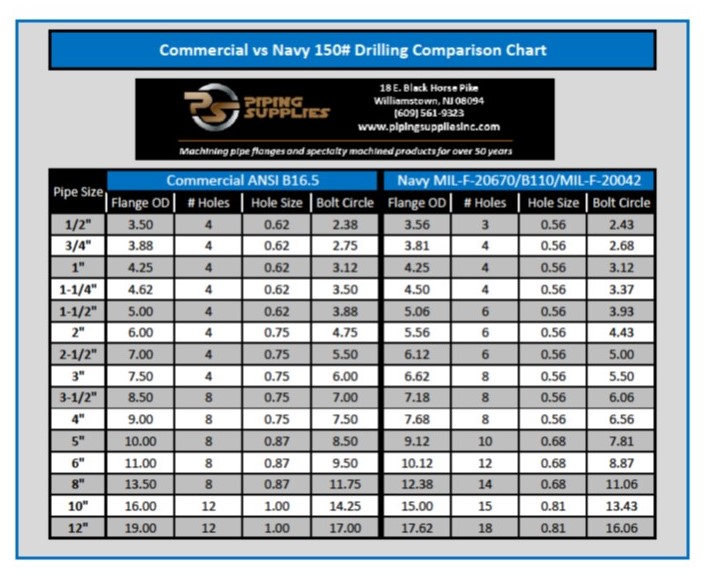Customers often contact Piping Supplies with requests for quotes that simply say “I want 2 – 1″ 150# flanges”. Or, customers will send a picture of a flange and are told, “We want another one of these”. As much as our sales people appreciate the inquiry, that’s not really enough information to provide an accurate quote. One of the most common difficulties our customers have is understanding the difference between commercial flanges and Navy flanges.
Piping Supplies has manufactured both commercial flanges and Navy flanges for over 50 years so it is easy for us to know the differences. There are four main features to look at to make sure you are ordering the correct flanges:
Identifying your flange
For the same pipe size flange look for:
- The outside diameter of the flange body
- The number of bolt holes
- Bolt hole diameter
- The distance between the centers of opposing bolt holes called the bolt circle or pitch circle
The outside diameter of Navy flanges are usually smaller than their commercial, ANSI B16.5, flange counterpart. This was originally to save weight on Navy ships.
The number of bolt holes and bolt hole diameter are related. Navy flanges use smaller bolts and sometimes need more of them to hold the same connection pressure.
The bolt holes are also smaller on Navy flanges than on Commercial flanges. The Navy specifications like MIL-F-20670 and MIL-PRF-20042 have bolt holes that are 1/16″ larger than the bolts to be used, with tighter tolerance on the bolt circle. ANSI B16.5 commercial flanges have bolt holes that are 1/8″ larger than the bolts to be used.
Because the outside diameter of the flange body is smaller and the bolt holes are usually smaller on Navy flanges, the bolt circle, sometimes called the pitch circle, is different between the two dimensional specs. This is yet another way to tell the difference between commercial and Navy flanges.
To help you identify the flange you have use this chart.
If you need more help with either commercial B16.5 flanges or any of the many Navy specifications, please contact any of our pipe flange experts directly. Thank you.


